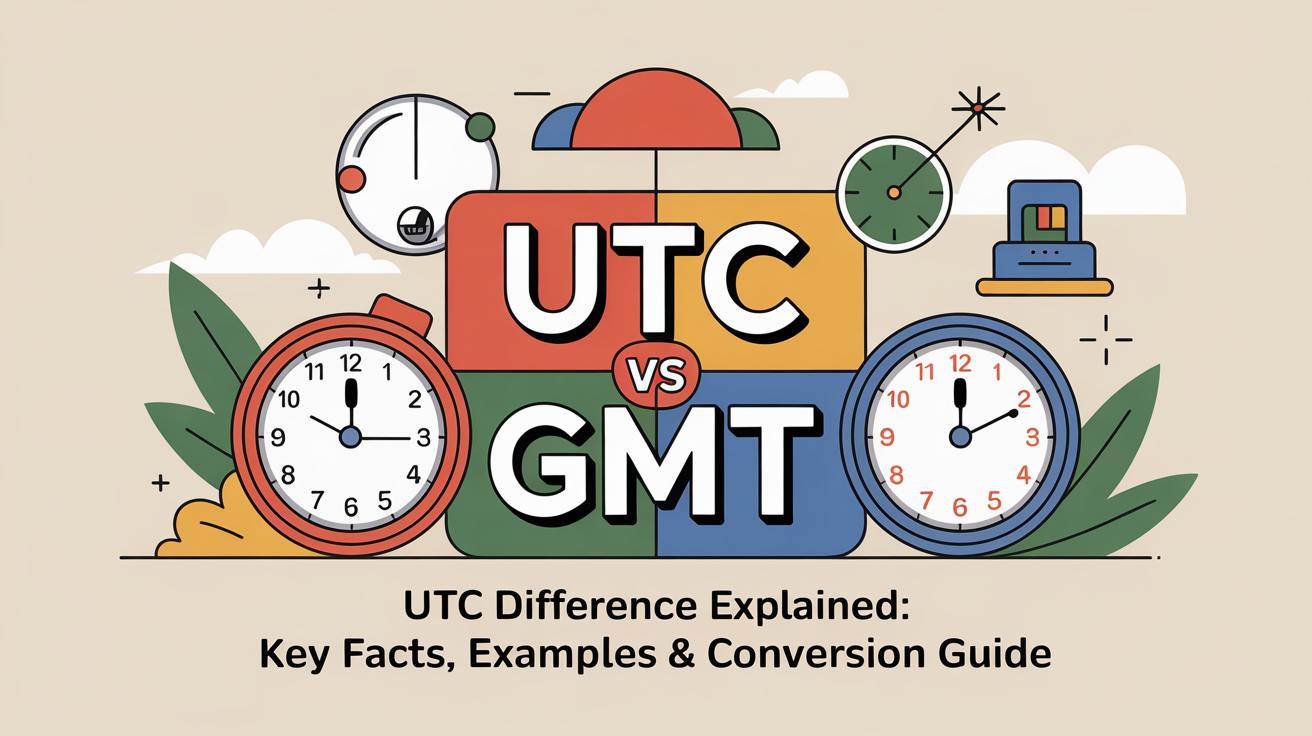Learn the clear difference between UTC and GMT. Understand their definitions, key differences, usage, and how to convert between them with practical examples for accurate global timekeeping.
UTC (Coordinated Universal Time) and GMT (Greenwich Mean Time) both measure time, but UTC is a precise atomic standard used worldwide, while GMT is a historical time zone based on Earth's rotation. UTC is consistent year-round, whereas GMT can vary slightly.
Time zones can be confusing, especially when acronyms like UTC and GMT are used interchangeably. Many people struggle to know which one to follow for scheduling, travel, or online meetings. If you’ve ever wondered whether GMT and UTC are the same or how they differ, you’re in the right place. In this article, we’ll break down their definitions, key differences, and practical usage, so you can understand them easily.
What is GMT?
Definition of GMT
Greenwich Mean Time (GMT) is the time zone originally established at the Prime Meridian in Greenwich, London. It represents the mean solar time at this longitude and has historically been used as the international standard for civil timekeeping. GMT does not change with the seasons and serves as a reference for time zones worldwide. For more details, you can check the official Royal Observatory Greenwich website.
History of GMT
GMT was first adopted in the mid-19th century to standardize time across railways and shipping schedules. Before GMT, local mean time was used, causing confusion in travel and communication. It became the world’s time standard until the 1970s, when atomic time measurement led to the creation of UTC.
Where GMT is Used Today
GMT is still used in the United Kingdom during winter months, and it serves as a time reference for aviation, broadcasting, and international communication. While most countries now rely on UTC for precision, GMT remains widely recognized for everyday purposes.
What is UTC?
Definition of UTC
Coordinated Universal Time (UTC) is the modern standard for timekeeping based on atomic clocks. Unlike GMT, UTC is extremely precise and consistent, ensuring that the world’s timekeeping is synchronized accurately. Learn more about UTC at Time and Date.
History of UTC
UTC was introduced in 1960 to provide a time standard unaffected by Earth's irregular rotation. It combines International Atomic Time (TAI) with occasional leap seconds to stay in sync with solar time. This makes UTC the most reliable global standard for science, navigation, and telecommunications.
Where UTC is Used Today
UTC is used as the primary time standard worldwide. All global time zones are defined relative to UTC, such as UTC+1, UTC-5, etc. It is essential in aviation, the internet, finance, and satellite communication to maintain precise timing.
Key Differences Between UTC and GMT
Difference in Definition
Feature
GMT
UTC
Type
Time zone based on Earth's rotation
Atomic time standard
Accuracy
Can vary slightly
Highly precise and stable
Basis
Mean solar time
International atomic time
Difference in Usage
GMT is often used in everyday conversation and historical references, while UTC is used for technical, scientific, and global applications.
Difference in Time Accuracy
GMT can drift due to Earth's rotation, whereas UTC uses atomic clocks and leap seconds to remain exact.
Difference in Global Applications
UTC is the universal reference for time zones, international flights, and computing systems, while GMT is mostly symbolic or used in specific regions like the UK.
How to Convert Between UTC and GMT
Converting between UTC and GMT is usually straightforward because the time difference is zero hours; both represent the same base time. However, GMT may be affected by daylight saving adjustments in some regions, whereas UTC never changes.
Step-by-Step Guide
- Identify the time zone you are converting from.
- Check for daylight saving time (DST) in the GMT region. If DST is in effect, GMT may be +1 hour.
- Adjust your time accordingly. If no DST is applied, UTC and GMT are the same.
- Use online tools like WorldTimeBuddy or Time and Date Converter for quick conversions.
Examples for Different Countries
- London, UK in winter: GMT = UTC
- London, UK in summer (DST): GMT +1 = UTC
- New York, USA: UTC-5 = EST, daylight savings may adjust to UTC-4
Tools and Websites for Conversion
For reliable UTC-GMT conversion, you can use:
- Time.is – Displays current UTC and local GMT simultaneously.
- World Clock by timeanddate.com – Allows you to compare multiple time zones instantly.
FAQs About UTC and GMT
Is GMT the same as UTC? GMT and UTC are often used interchangeably in everyday contexts, but they are not exactly the same. GMT is a time zone based on Earth’s rotation, while UTC is a precise atomic time standard. For most practical purposes, they match, except during daylight saving adjustments.
Which is more accurate, UTC or GMT? UTC is more accurate because it relies on atomic clocks and includes leap seconds to stay aligned with the solar day. GMT, based on Earth’s rotation, can vary slightly over time.
Can we use UTC instead of GMT? Yes, UTC is now the global standard for aviation, computing, and international communication. GMT is mainly used for historical references or regional purposes, such as the UK in winter.
Does GMT change with daylight saving time? Yes, GMT can shift during daylight saving periods in certain regions, but UTC never changes, making it the preferred reference for precise timing.
Why is UTC important for global systems? UTC ensures synchronized time across the world, which is essential for satellites, internet servers, financial transactions, and air traffic control. Learn more at NIST UTC Overview.
Conclusion
Understanding the difference between UTC and GMT is crucial for accurate timekeeping, scheduling, and global communication. While GMT is a historical time zone based on Earth's rotation, UTC is a precise atomic standard used worldwide. UTC provides consistent, reliable timing, making it essential for technology, aviation, and international coordination. By knowing how to convert and apply each, you can avoid confusion and stay on schedule, no matter where you are in the world.
